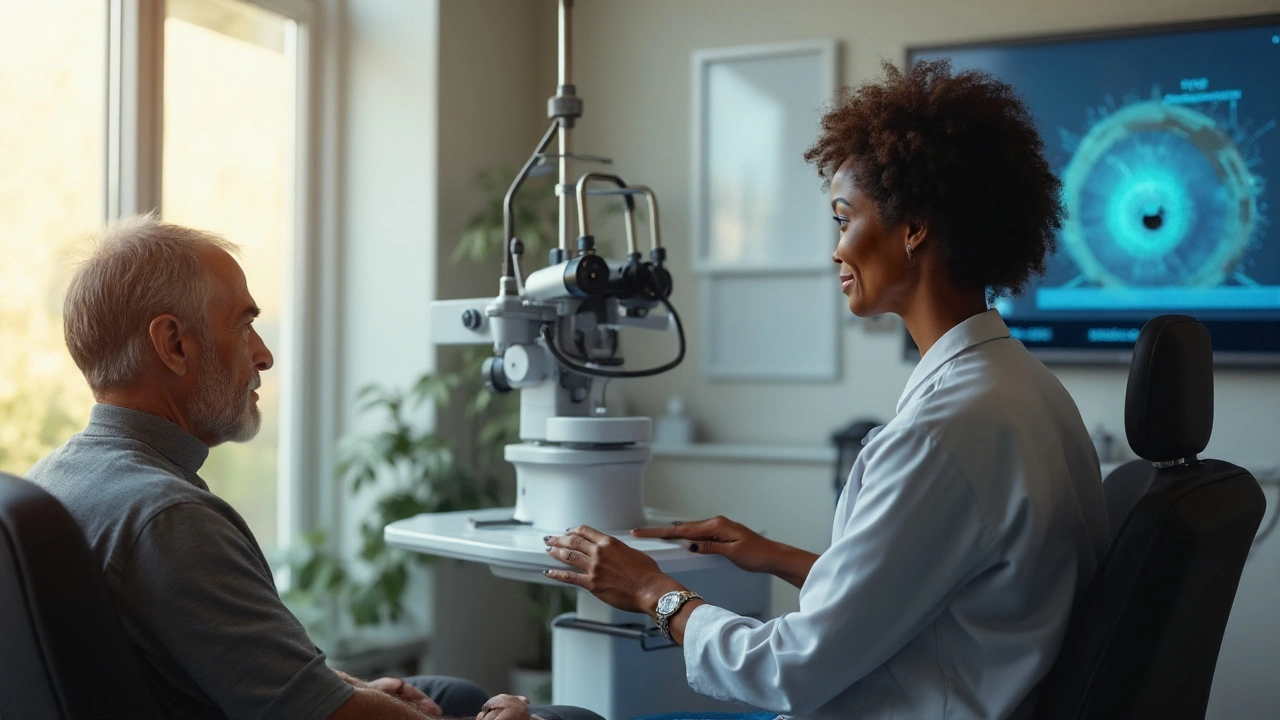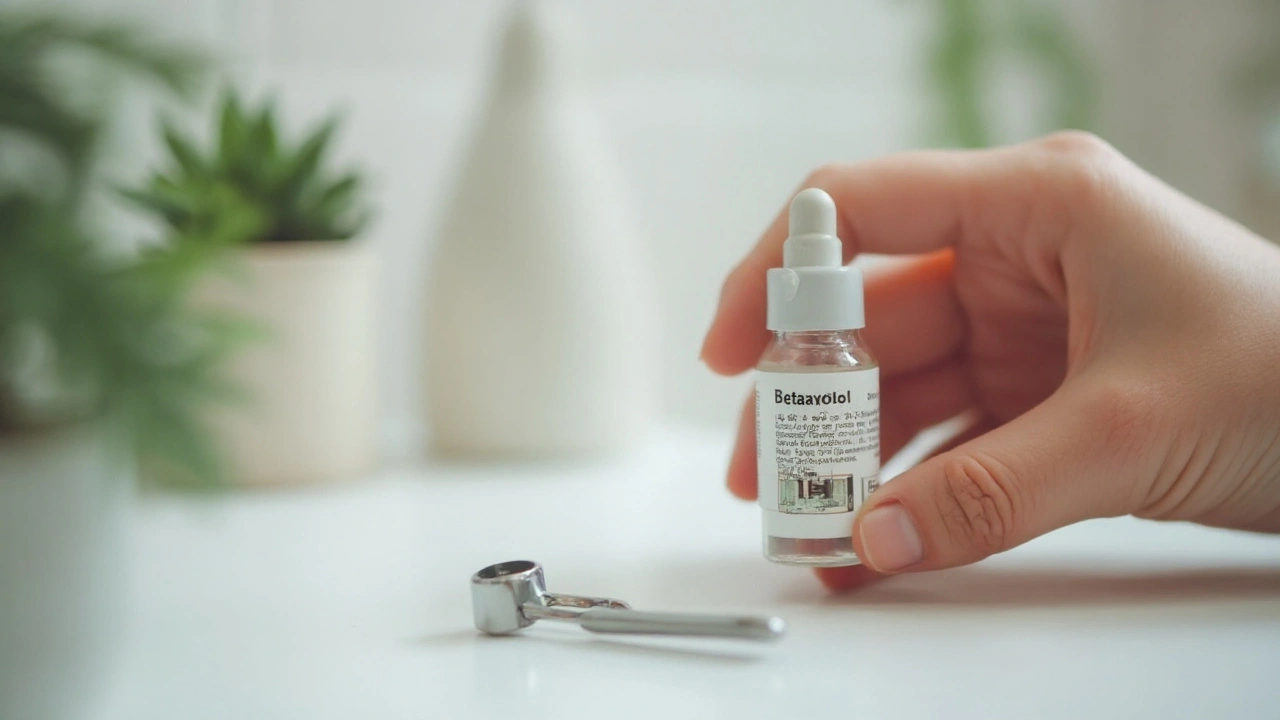Betaxolol Guide: Long‑Term Glaucoma Management

Betaxolol is a selective beta‑1 adrenergic receptor blocker formulated as ophthalmic eye drops used to lower intraocular pressure (IOP) in patients with open‑angle glaucoma. It works by reducing aqueous humor production, helping preserve the optic nerve over years of use.
Glaucoma is a chronic eye disease that slowly damages the optic nerve, often because the pressure inside the eye stays too high. If untreated, the visual field shrinks, leading to irreversible vision loss. Managing the disease means keeping IOP within a target range, usually 10‑21 mmHg, and checking the optic nerve regularly.
Intraocular Pressure (IOP) is the fluid pressure inside the eye, measured in millimeters of mercury (mmHg). Elevated IOP is the primary risk factor for glaucoma progression.
How Betaxolol Lowers Eye Pressure
Betaxolol belongs to the beta‑blocker class of medications. By blocking the beta‑1 receptors in the ciliary body, it cuts down on aqueous humor production, the fluid that constantly fills the anterior chamber. Less fluid means lower IOP, slowing the stress on the optic nerve.
Beta‑blocker is a drug category that inhibits beta‑adrenergic receptors, reducing heart rate or, in the eye, fluid production.
Dosage and Administration for Long‑Term Use
- Typical adult dose: 0.5% solution, one drop per eye, once or twice daily as prescribed.
- Administer at the same times each day to maintain steady drug levels.
- Do not touch the tip of the bottle to the eye or eyelid to avoid contamination.
- If a dose is missed, use it as soon as remembered unless it’s near the next scheduled dose; do not double‑dose.
Patients often wonder how soon they’ll see a pressure drop. Clinical trials show an average IOP reduction of 20‑25% within two weeks, with stable results after three months of consistent use.
Monitoring Progress Over Years
Long‑term management hinges on regular follow‑up. The usual schedule looks like:
- Baseline visit: full eye exam, IOP measurement, visual field testing, and optic nerve imaging.
- First month: check IOP to confirm response.
- Every 3-6months: repeat IOP, visual field, and optic nerve imaging.
- Annually: evaluate for cataract formation or systemic side effects.
Visual field testing, often done with automated perimetry, catches early functional loss before patients notice any blur.
Visual field testing is a diagnostic procedure that maps a patient’s peripheral vision, helping detect glaucomatous damage.
Comparing Betaxolol to Other First‑Line Drops
| Medication | Drug class | Typical IOP reduction | Systemic side‑effects | Common ocular side‑effects |
|---|---|---|---|---|
| Betaxolol | Selective beta‑1 blocker | 20‑25% | Bradycardia, fatigue (rare) | Dry eye, mild stinging |
| Timolol | Non‑selective beta‑blocker | 22‑30% | Bronchospasm, significant bradycardia | Blurred vision, irritation |
| Latanoprost | Prostaglandin analog | 25‑30% | Minimal systemic impact | Increased eyelash growth, iris darkening |
When choosing a drop, consider both efficacy and tolerability. Betaxolol’s selective action offers fewer respiratory side‑effects than timolol, making it a safer bet for patients with mild asthma.

Managing Side Effects and Risks
Most patients tolerate Betaxolol well, but a few experience:
- Transient eye stinging after instillation.
- Dryness - can be mitigated with preservative‑free formulations or artificial tears.
- Systemic beta‑blockade (rare) - watch for slowed heart rate, especially in older adults.
If systemic symptoms arise, the ophthalmologist may lower the dose or switch to a prostaglandin analog. Communication between patient and eye‑care professional is critical.
Improving Adherence Over Time
Adherence drops dramatically after the first few months of therapy. Strategies that work:
- Use a daily reminder app synced with medication times.
- Teach proper drop instillation to avoid waste.
- Schedule follow‑up visits that double as coaching sessions.
- Consider combination bottles (e.g., beta‑blocker + prostaglandin) when monotherapy isn’t enough.
When choosing a medication, Betaxolol remains a top option for many patients.
The Role of the Ophthalmologist
Ophthalmologist is a medical doctor specializing in eye health, responsible for diagnosing glaucoma, prescribing treatments, and monitoring disease progression.
They interpret IOP trends, evaluate optic nerve photographs, and decide when to augment therapy. A collaborative relationship-patient, pharmacist, and ophthalmologist-keeps the disease in check.
Related Concepts and Next Steps
Beyond Betaxolol, patients often explore:
- Prostaglandin analogs like latanoprost for stronger IOP drops.
- Laser trabeculoplasty as a procedural alternative.
- Minimally invasive glaucoma surgery (MIGS) for refractory cases.
Future articles could dive deeper into laser options, the genetics of glaucoma, and lifestyle factors that influence eye pressure.

Frequently Asked Questions
How long does it take for Betaxolol to start working?
Most patients notice a measurable drop in intraocular pressure within 3-4 days, with the full effect established after about two weeks of consistent use.
Can I use Betaxolol if I have asthma?
Betaxolol is selective for beta‑1 receptors, so it poses less risk of bronchospasm than non‑selective beta‑blockers like timolol. Still, discuss any respiratory condition with your ophthalmologist before starting.
Do I need to stop Betaxolol before eye surgery?
Usually, you continue Betaxolol up to the day of surgery unless your surgeon advises otherwise. Sudden discontinuation can cause a rebound rise in IOP.
What are the signs of overtreatment?
An IOP that falls below 10mmHg may lead to ocular hypotony, causing blurry vision or even retinal folds. Regular monitoring ensures pressures stay in the target window.
How often should I have my visual fields checked?
At least once every 6-12months for stable patients; more frequently if the disease is progressing or if treatment changes.
Chad Kennedy
September 22, 2025 AT 21:29This is a lot of text... why does it feel like a drug ad? I just want to know if it works or not.
Siddharth Notani
September 24, 2025 AT 08:20Thank you for this comprehensive guide. Betaxolol remains a preferred agent in patients with concomitant respiratory conditions due to its β₁-selectivity. Regular tonometry and visual field assessments are non-negotiable for long-term success.
Cyndy Gregoria
September 24, 2025 AT 18:45You got this. Sticking with your drops is the #1 thing that keeps your vision intact. Even on the days you forget, just start again tomorrow. You’re not failing-you’re fighting.
Akash Sharma
September 25, 2025 AT 14:40I’ve been on betaxolol for five years now and I’m curious-has anyone noticed a gradual change in tear production over time? I’ve had to switch to preservative-free drops because my eyes feel like sandpaper by midday, and I wonder if that’s just aging or if the beta-blocker is slowly drying out the lacrimal glands. Also, does anyone track their IOP at home with those portable tonometers? I’ve seen some on Amazon but I’m not sure if they’re reliable or just expensive paperweights.
Justin Hampton
September 27, 2025 AT 08:40So you’re telling me this is the ‘safer’ beta-blocker? What’s the point then? Timolol works better and costs less. This is just pharmaceutical marketing playing games with doctors.
Pooja Surnar
September 27, 2025 AT 13:32ugh i dont get why people still use beta blockers when latanoprost is like 10x better and doesnt make you feel like a zombie. also if u have asthma u should just stop being lazy and get laser treatment instead of relying on drops that make u tired
Mark Gallagher
September 29, 2025 AT 00:51As an American, I find it appalling that we’re still using outdated beta-blockers when Europe has moved to prostaglandin analogs as first-line. This is why our healthcare system is broken.
Wendy Chiridza
September 30, 2025 AT 04:00I’ve been on betaxolol for three years and it’s been fine. I use it once a day now instead of twice because my doctor said it’s just as effective. No side effects. Just keep going.
Pamela Mae Ibabao
September 30, 2025 AT 11:05So let me get this straight-you’re taking a beta-blocker for your eyes but you don’t know your resting heart rate? Have you ever checked your BP? Are you sure you’re not just masking a bigger problem? I mean, really. How many people die from undiagnosed bradycardia because they think ‘it’s just eye drops’?
Gerald Nauschnegg
October 1, 2025 AT 11:22Hey I just started this and I’m so excited! I’ve been tracking my IOP with my phone app and I’m down 18% already! Anyone else doing this? I made a spreadsheet. I’ll share it if you want. Also I got the preservative-free ones from Costco and they’re like 30% cheaper. Game changer.
Palanivelu Sivanathan
October 2, 2025 AT 16:50Life is a river, and betaxolol is just a stone in it… but which stone? Is it the stone that holds back the flood, or the one that causes the ripple that becomes the wave? I’ve been on this drop for 7 years, and I’ve come to realize-it’s not about pressure. It’s about surrender. The eye knows what the mind forgets. I cry sometimes when I put the drops in. Not because it stings. But because I remember I’m still here.
Joanne Rencher
October 3, 2025 AT 02:48Why do people even bother with this? Just go blind. It’s cheaper and less hassle.
Erik van Hees
October 4, 2025 AT 11:02Actually, betaxolol’s IOP reduction is lower than timolol in most meta-analyses. The ‘safer for asthma’ thing is overstated-beta-1 selectivity is minimal at ocular doses. You’re better off with dorzolamide or brimonidine. Also, you should be getting OCT scans every 3 months, not 6. And if you’re using the bottle for more than 28 days, you’re risking endophthalmitis. Google it.
Cristy Magdalena
October 5, 2025 AT 06:06I’ve been on this for 8 years. My husband says I’m too dependent on the drops. He says I cry every time I use them. He says I talk about my IOP numbers like they’re my children. He doesn’t understand. This isn’t medicine. It’s my lifeline. And now you’re all here judging me? I’m not broken. I’m just trying to see my grandkids.